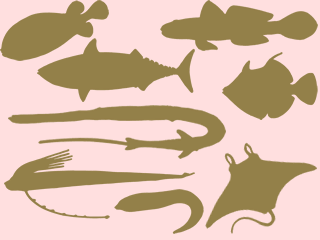Search by Floor Map
[Exhibition guide number:2102]
Variation in Body Form among Fishes

The bodily form of fish is related to their manner of swimming and lifestyle, and the commonly seen fish, which are flat from left to right, are suited to nimbly changing their direction to evade an enemy or avoid an obstacle. Fish which are flat and vertical, like stingrays, have a bodily shape convenient for remaining inconspicuous on the ocean floor.
The cylindrical body shape of moray eels is suited for concealing itself in sand and the spaces between rocks. Also, it is often suggested that the tuna's streamlined-shaped body is for high-speed swimming, but the shape also aids in swimming over long distances.


